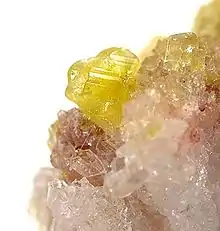| Sklodowskite | |
|---|---|
 Sklodowskite on gypsum | |
| General | |
| Category | Nesosilicate |
| Formula (repeating unit) | Mg(UO2)2(HSiO4)2·5H2O |
| IMA symbol | Sds[1] |
| Strunz classification | 9.AK.10 |
| Crystal system | Monoclinic |
| Crystal class | Prismatic (2/m) (same H-M symbol) |
| Space group | C2/m |
| Identification | |
| Colour | Light yellow to green-yellow |
| Cleavage | Perfect on {100} |
| Mohs scale hardness | 2 - 3 |
| Lustre | Adamantine, vitreous, silky |
| Streak | Yellow |
| Diaphaneity | Transparent, translucent |
| Density | 3.54 g/cm3 |
| Other characteristics | |
Sklodowskite is a uranium mineral with the chemical formula: Mg(UO2)2(HSiO4)2·5H2O. It is a secondary mineral which contains magnesium and is a bright yellow colour, its crystal habit is acicular, but can form in other shapes. It has a Mohs hardness of about 2–3. It is named after the maiden name of Marie Skłodowska Curie.[2] It is the magnesium analogue of the much more common uranium mineral Cuprosklodowskite, which contains copper instead.
It was discovered by Alfred Schoep (1881–1966) in 1924.
References
- ↑ Warr, L.N. (2021). "IMA–CNMNC approved mineral symbols". Mineralogical Magazine. 85 (3): 291–320. Bibcode:2021MinM...85..291W. doi:10.1180/mgm.2021.43. S2CID 235729616.
- ↑ "Sklodowskite". mindat.org.
- A. Schoep, La sklodowskite, nouveau mineral radioactif, C. R. Acad. Sci. Paris, 179, 143 (1924)
This article is issued from Wikipedia. The text is licensed under Creative Commons - Attribution - Sharealike. Additional terms may apply for the media files.